July 30, 2011–January 1, 2012
ART GALLERY OF ONTARIO
The Art Gallery of Ontario is currently home to the exhibition Haute Culture: General Idea, which was first exhibited in Paris by French curator Frederic Bonnet. Located on the fourth and fifth floors, Haute Culture features work produced by a collaboration of gay male artists including AA Bronson, Felix Partz and Jorge Zontal. The works consist of a wide variety of practices and artistic media, many dealing with the artists’ sexual orientation. Ranging from paintings, installations, photographs, drawings and videos, the artwork, devised between 1969 and 1994, forecast aspects of today’s trends in art and media culture.
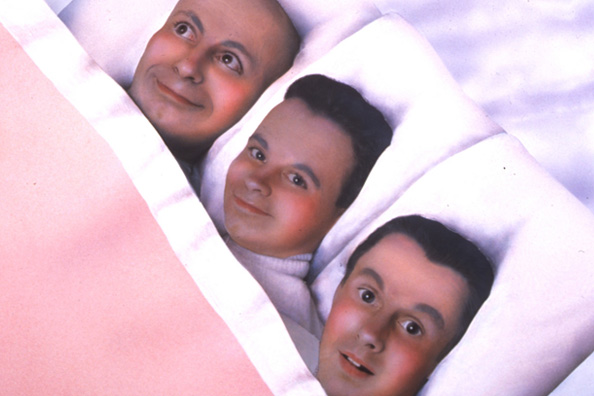 Baby Maker 3, 1984-1989, cromogenic print, 76.2 x 63.5 cm. Collection Fonds national d’art contemporain, France. Image courtesy the Estate of General Idea and the Art Gallery of Ontario.
Baby Maker 3, 1984-1989, cromogenic print, 76.2 x 63.5 cm. Collection Fonds national d’art contemporain, France. Image courtesy the Estate of General Idea and the Art Gallery of Ontario.
Standing outside the doors of the Art Gallery of Ontario is General Idea‘s newly installed “AIDS” sculpture, acting as a representative for the exhibition inside. As one walks past this enormous sculpture saturated with coloured graffiti, it is evident that the design of the sculpture “AIDS” is directly imitating and responding to Robert Indiana’s red and blue “LOVE” sculpture, currently on the streets of New York City. The placement of the “AIDS” sculpture is an important and successful part of Bonnet’s exhibition strategy, allowing spectators to contemplate concepts and themes embedded in the exhibition prior to seeing it. Although this sculpture strikes an impression for viewers, its creation in the 1980’s must have been much more shocking and scandalous. Therefore, the historical time frame and context in which this sculpture is exhibited is an important part of how it is received by its audience. Presenting this sculpture in the year 2011 when the term AIDS is no longer alien to the public lessens the shock value.
Once inside, the fourth floor of the AGO’s contemporary and architecturally-savvy gallery houses a handful of rooms dedicated to exhibiting artwork generated by Bronson, Partz and Zontal. Each room is saturated with a variety of colourful artwork, including a Miss General Idea pavilion, heraldry, and installation pieces acting as mini exhibitions in and of themselves. The crisp white walls in this space intelligently bring the artwork and installations to life. One of the rooms in the gallery space is eerily dedicated to the 1971 Miss General Idea pageant. The work titled Miss General Idea is composed of posters, letters, video footage and clothing from the 1971 pageant, exposed for the audience to see. Although this pageant did exist, “Miss General Idea” did not. There was no winner; it was a show put on by women for the amusement of themselves and men in the 1970’s. Miss General Idea represents the intermingling of reality, fiction and parody, linking together thematic ideas embedded in works of art. It would be wise for Bonnet to have devised written texts alongside the Miss General Idea piece, explaining in further detail the intention behind its existence in a more obvious and straightforward manner for viewers.
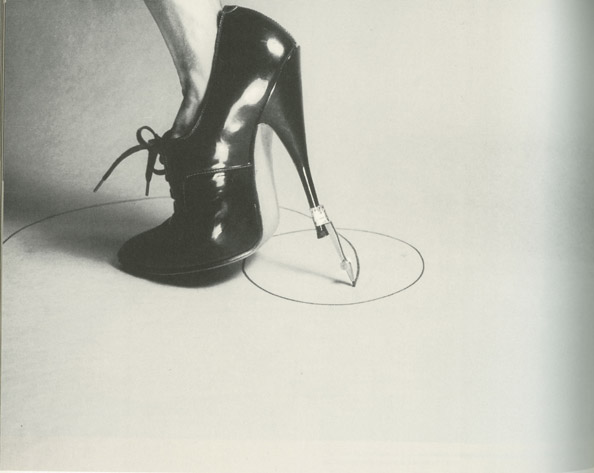 General Idea. No Mean Feet, 1973-74, photography, 27.9 x 43.2 cm. Image courtesy Galerie Esther Schipper
General Idea. No Mean Feet, 1973-74, photography, 27.9 x 43.2 cm. Image courtesy Galerie Esther Schipper
The works of art in Haute Culture: General Idea are not organized in a chronological manner; rather they are clustered together in groupings. The groupings may not seem obvious at first. However, after a second walk-through of the exhibition it becomes clear that each is based on a concept or thematic idea. These themes consist of glamour as an artistic tool, the mass media and culture, and sexuality and disease, specifically AIDS. The most successful rooms, in my opinion, are isolated works consisting of bright coloured wallpaper and paintings dedicated to AIDS, illuminating this theme and conceptual idea.
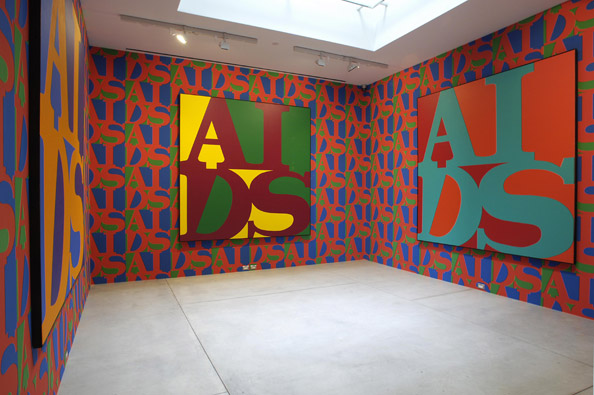 AIDS (Installation view), 1988, acrylic on canvas. Image courtesy The Art Gallery of Ontario, 243.7 x 243.7 cm. Collection of The Art Gallery of Ontario, Toronto. Gift of Robert and Lynn Simpson, 1997. Image by Carlo Catenazzi, courtesy of the Art Gallery of Ontario
AIDS (Installation view), 1988, acrylic on canvas. Image courtesy The Art Gallery of Ontario, 243.7 x 243.7 cm. Collection of The Art Gallery of Ontario, Toronto. Gift of Robert and Lynn Simpson, 1997. Image by Carlo Catenazzi, courtesy of the Art Gallery of Ontario
Other themes in the exhibition are less obvious, due to the large amount of grouped tightly together. It is unclear whether or not this was done intentionally by the curator. As one walks through the exhibition, the specific artist responsible for creating certain works remains anonymous. For many, this may seem like a curatorial catastrophe. However, when close attention is paid to the exhibition, it becomes clear that Bonnet does this purposefully.
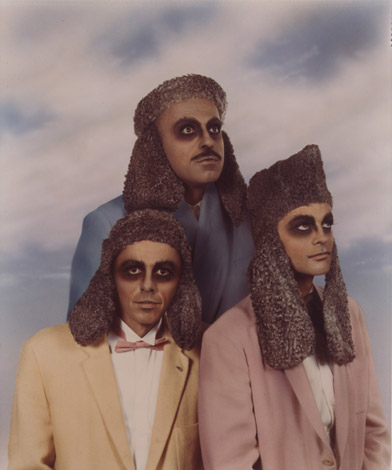 General Idea. P is for poodle, 1983-1989, lacquer on vinyl, 200 x 160 cm. Image courtesy Galerie Frédéric Giroux, Paris
General Idea. P is for poodle, 1983-1989, lacquer on vinyl, 200 x 160 cm. Image courtesy Galerie Frédéric Giroux, Paris
Quoting Bronson, Partz and Zontal, Bonnet writes, “General Idea broke with the concept of the author by adopting a generic title that freed the artists from the tyranny of the myth of the individual genius.” As part of the artists’ motive of being “freed of individual genius,” it is only fitting that specific artworks exist mysteriously and uncredited throughout the exhibition.
Throughout the exhibition, beginning outside the doors of the AGO, the theme of AIDS is embedded within each group of work. The word appears in paintings, on walls, and even as an accessory in the Miss General Idea installation. Its purpose is, of course, to bring awareness to this disease, which ultimately claimed the lives of two of the three artists who collaborated on the artwork displayed.
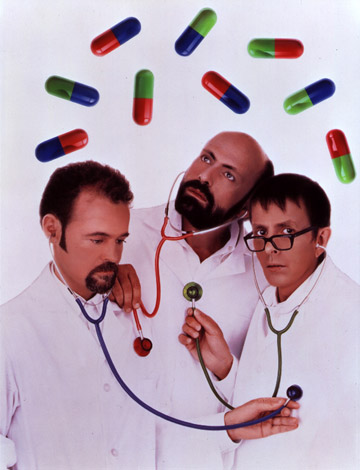 General Idea. Playing Doctor, 1992, chromogenic print, 76.2 x 53.3 cm. Image courtesy the estate of General Idea.
General Idea. Playing Doctor, 1992, chromogenic print, 76.2 x 53.3 cm. Image courtesy the estate of General Idea.
However, the use of this disease throughout Haute Culture: General Idea is as much metaphorical as it is literal. The exhibition itself becomes a virus inserted into each viewer’s mind in the world of glamour and mass media.
Amanda Pignotti
